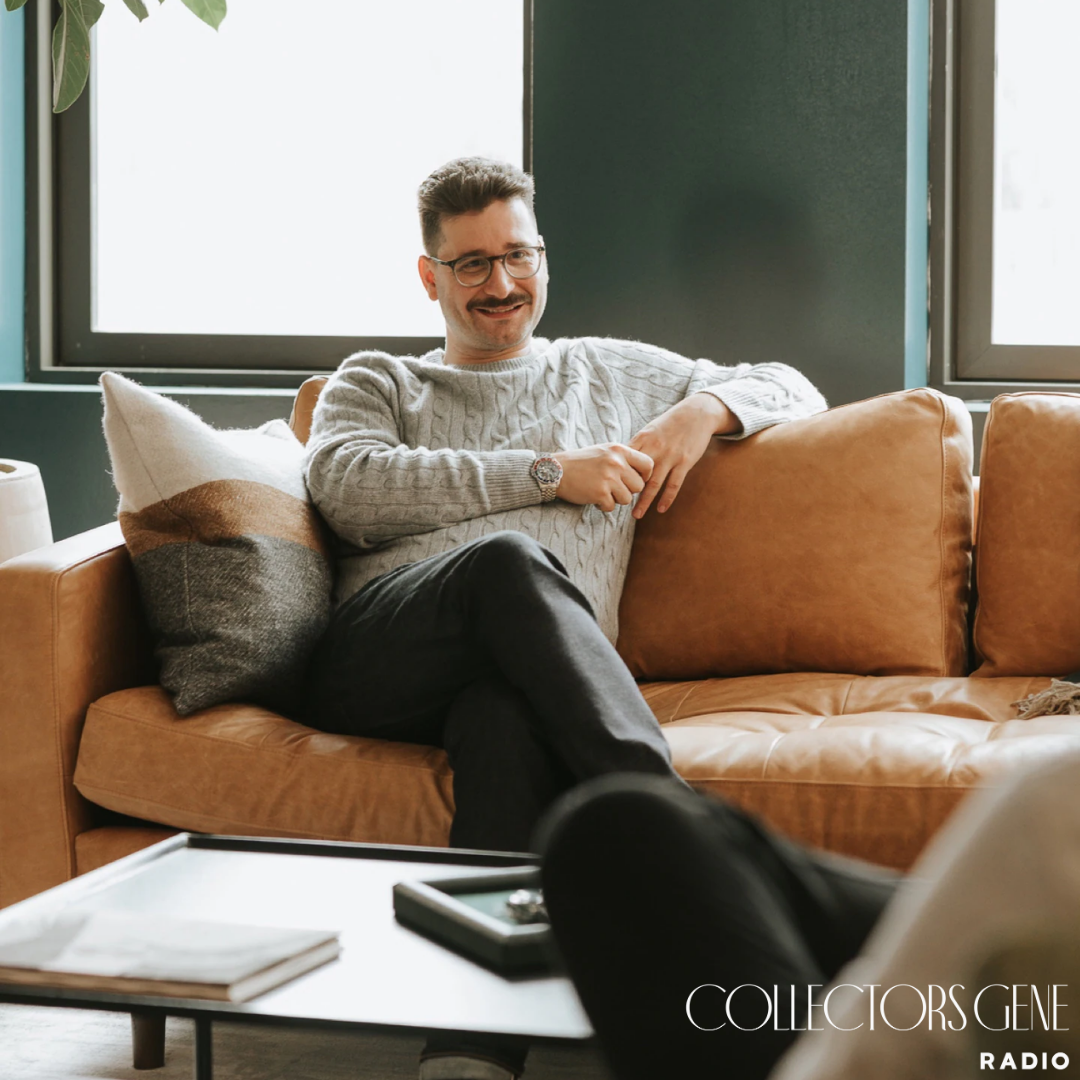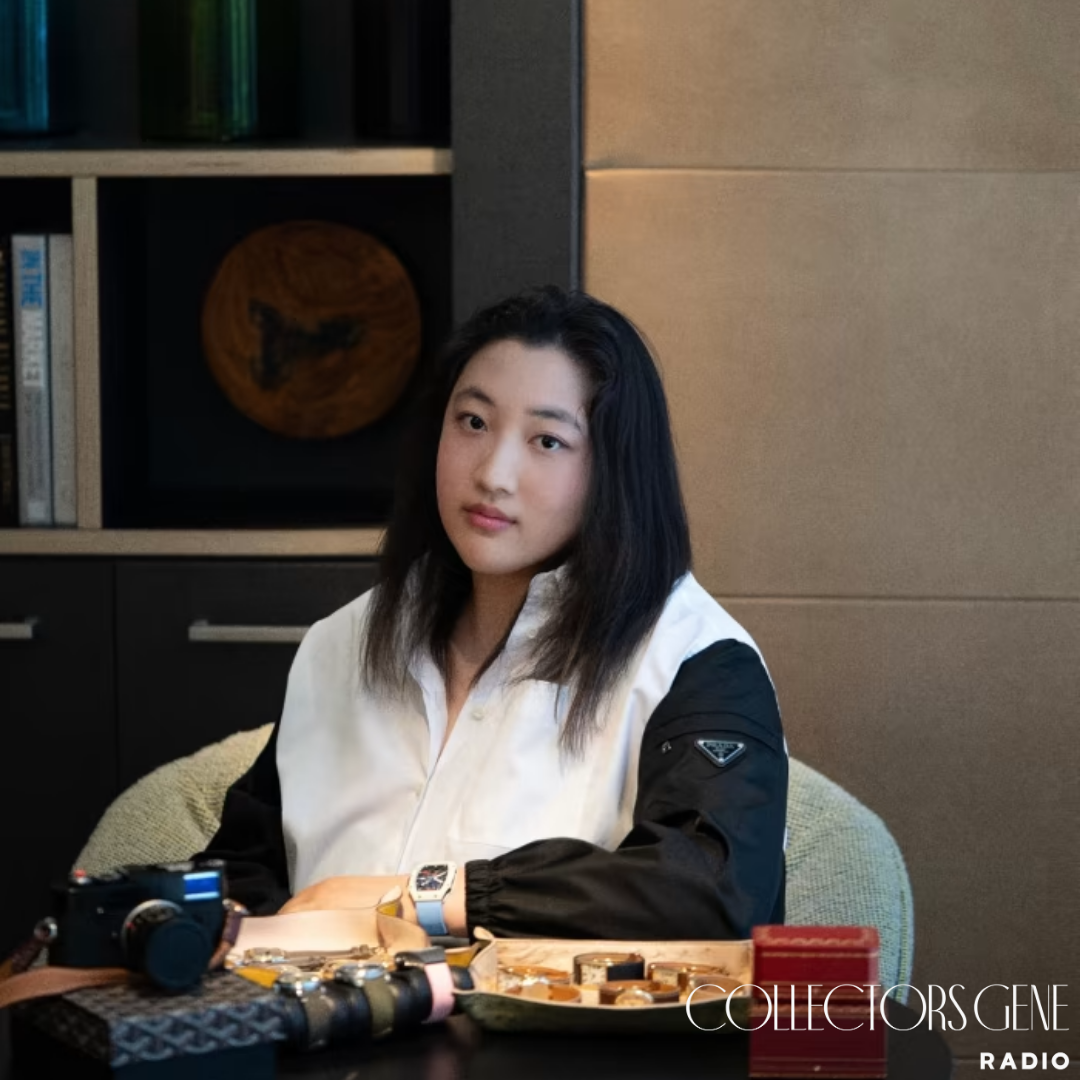Collectors always surprise me, not because they collect, I expect that, but because of how. The spark, the trigger, the thing that keeps them going. When Paul Croughton, the Editor in Chief of Robb Report, reached out as a listener of the show, I had a feeling there was a collector behind the editor’s title. What I didn’t know was how deep his roots went: Smurfs and stickers as a kid, shelves of vinyl and magazines as an adult, and eventually the refined obsessions of barware, art, and watches.
What makes Paul particularly fascinating is that his professional world is also about collecting, though at a different scale. He has spent decades shaping magazines that are curated collections in their own right, assemblies of voices, images, and ideas that capture the culture of luxury. Moving from the UK to the U.S. to take over Robb Report, he’s essentially built a career out of curation. And when you hear him talk about the thrill of filling a sticker album or tracking down a Napier cocktail shaker, you realize the personal and professional instincts are intertwined.
Early Sparks and Refining Taste
Paul’s first collection wasn’t sophisticated. It was Smurfs. Dozens of little blue figurines lined up on a shelf, each one saved for or traded. From there it became soccer stickers, those albums that could consume a childhood until the last elusive square was filled. That sense of completion, of finishing something tangible, left a permanent mark.
As he grew older, the objects shifted but the instinct stayed the same. By his twenties he was archiving vinyl and magazines, thousands of them, building collections that became both a blessing and a burden. Before moving to New York he faced the painful purge of letting most of it go. But even that process, he explained, was part of the lesson. “Refining possessions,” as he put it, can be as valuable as acquiring them. It wasn’t just about owning but about editing, shaping, curating.
From the Page to the World of Luxury
Paul’s editorial career began at Arena, moved to The Sunday Times, and eventually led him to launch Robb Report UK in 2016. Unlike the franchise model of reprinting American content, his version was built from scratch with wit, personality, and a sharper edge. That boldness caught the attention of the U.S. parent company, and before long, Paul was running Robb Report globally.
For him, a good magazine is like a great dinner party. You want variety, surprise, and flow from one course to the next. That approach mirrors collecting itself. A collection shouldn’t be predictable or one-note; it should spark joy and curiosity, even when it doesn’t follow the obvious path.
Tyler, The Creator and Taste Without Rules
That philosophy carried into one of his most memorable assignments: profiling Tyler, The Creator. Tyler had shown glimpses of his collections, Cartier watches, trunks, bikes, but never the full picture. Paul pitched him directly, writing a letter about how intentional and unusual his taste really was. The pitch worked. Tyler agreed, but only if he could shape the piece himself, from the photography to the edits.
What came out of it was less a profile than a manifesto. Tyler told him, “I might shave my head and become vegan in ten years and not care about any of this. So I want to showcase it now, while I’m in this mood.” For Paul, that line defined collecting. It’s not speculation; it’s about the joy of living with something now. Tyler sweats in his Cartier tanks, rides his bikes, uses his trunks. Nothing is kept behind glass. That sense of immediacy is something Paul admires and relates to, whether in barware, records, or watches.
A Bar Cart Full of History
Of all his collections, vintage barware is the most unexpected. It started innocently enough with a pair of seltzer bottles from a Buenos Aires flea market, followed by a cocktail trolley spotted on the way to a football match. Soon the collection grew to include shakers, jiggers, and spoons, most from the art deco era.
One standout is Napier’s 1936 penguin cocktail shaker, a twelve-inch stainless steel sculpture that doubles as a piece of functional design. But he’s just as charmed by whimsical pieces: a musical jigger that plays a tune while you pour, cat-shaped shakers with bells inside, spoons that have stirred martinis for a century. These aren’t objects to hide in a cabinet. They’re meant to be used, alive with history every time they mix a drink.
Watches and Quiet Elegance
Paul’s relationship with watches followed the familiar arc: Swatch as a kid, TAG Heuer Formula 1 in his teens, then a gradual move toward vintage elegance. Today his collection leans toward mid-century Vacheron Constantin and Cartier, watches that reflect proportion and dial work rather than complications. He keeps a Speedmaster as his one chronograph icon, but most often wears 33–37mm watches that reveal their charm slowly.
What he loves most is their understatement. A well-designed Vacheron from the 1950s, he insists, is as rewarding as any modern hype watch, just without the noise.
Collecting as Escape
With a career built around covering every corner of luxury, you’d think Paul would burn out. But he describes collecting as his escape. There are times he puts something down, only to rediscover it later with fresh energy. Barware has been that way for him. The cycle of obsession, pause, and return is part of what keeps it rewarding. Collecting, for him, is about finding rhythm in the hunt and living with the joy of the pieces once they’re found.
The Collectors Gene Rundown
The One That Got Away: A Napier penguin shaker he once passed on. A friend bought it, which forced him to admit how badly he wanted it. He later found one in perfect condition.
The On Deck Circle: More barware, especially whimsical deco-era pieces like picks and menus.
The Unobtainable: Art by Idris Khan and Chi Sung Woo, and rare vintage Cartier watches from Harry Fane’s archives.
The Page One Re-Write: If he weren’t collecting barware and watches, he’d collect young artists, watching their careers unfold alongside his collection.
The GOAT: Collectors with their own esthetic: Auro Montanari with his unusual watches, Roni Madhvani with asymmetric cases, Mark Cho for championing small watches and personal style.
The Hunt or The Ownership: Both matter, but ownership wins because a shaker should be used, a watch worn, and art hung.
Do You Feel That You Were Born With The Collector’s Gene?: Maybe not born with it, but it’s become a defining trait shaped by his father and his own obsessions.
Closing Thoughts
Paul’s refreshing take on collecting proves that the hobby doesn’t always have to be about rarity or value. Sometimes it’s about play, humor, and the spark that makes you smile when you hold something. Whether it’s a Smurf from childhood, a penguin-shaped shaker, or a Vacheron from the 1950s, the thread is joy.
Coming out of my talk with Glenn Spiro about stones and instinct, Paul’s story felt like a continuation of that theme, but applied to the everyday objects of culture. Glenn buys a pink diamond sight unseen; Paul chases a cocktail shaker across flea markets. Both approaches hinge on instinct and love, not analysis. That, to me, is what keeps this series alive: each guest showing us a different angle of the same truth, that the collector’s gene expresses itself in endless, surprising ways.





